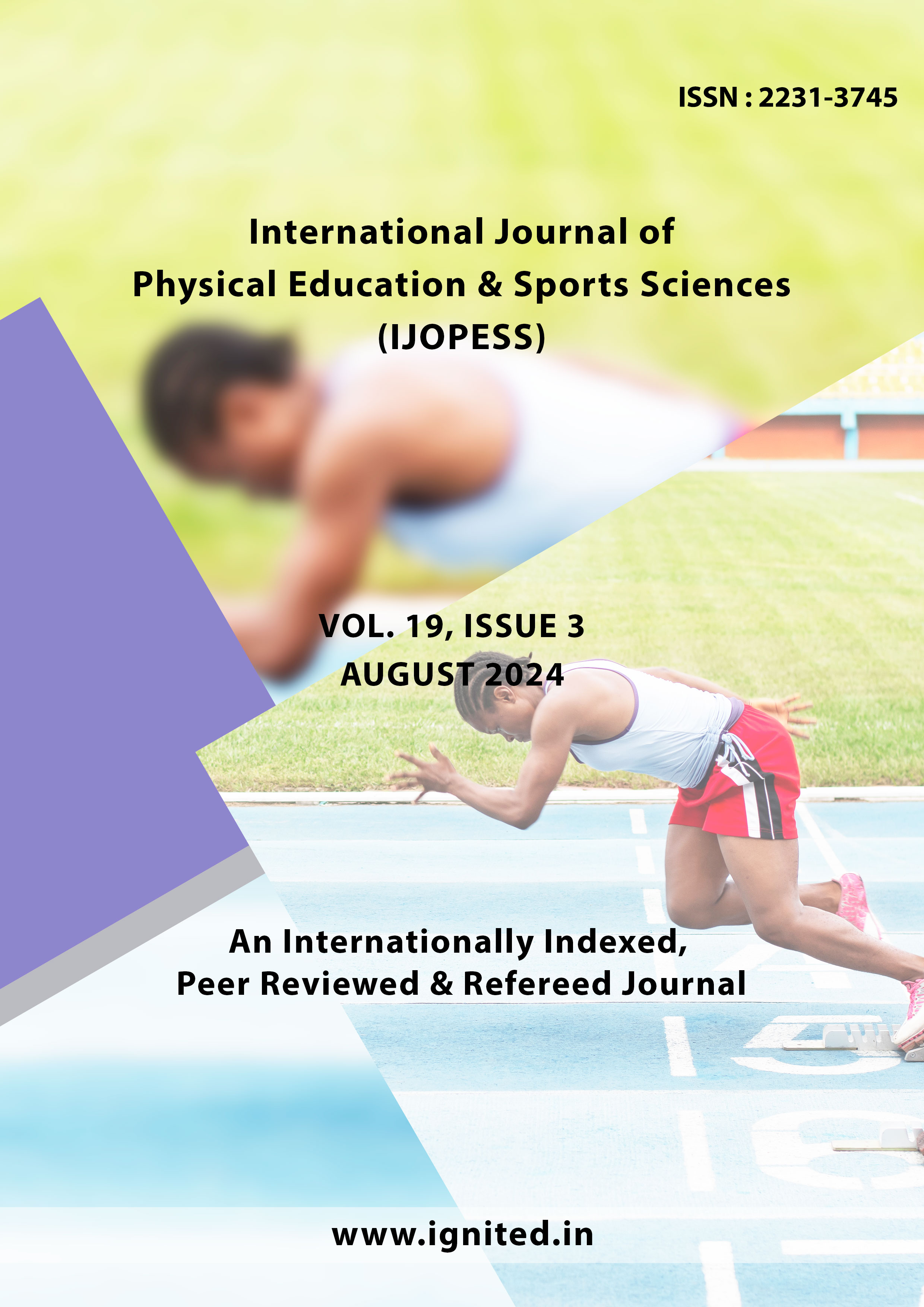VO2max Estimation from Up and Down Staircase Running test for College Level Students
Main Article Content
Authors
Abstract
Objective: The goal of the study was to create a submaximal exercise test that uses a three-minute up-and down staircase running exercise to estimate VO2 max.
Methods:78 male college students, ages 18 to 22, were chosen to serve as test validation subjects. To find their VO2max, the participants finished a treadmill test at the human performance laboratory at LNIPE in Guwahati, India. After a three-minute up-and-down stairway running exercise, the subjects had a one-minute heart rate response. Age in years was noted, and BMI was evaluated. The multiple regression model used the directly measured VO2max data from the treadmill test as the dependent variable, and the number of turns in the 3-minute up-and-down staircase running performance, post-exercise heart rate 1-minute response, BMI, and age in years as the independent variables.
Results: Male VO2max (ml/kg/min) was estimated using the multiple regression equation, which produced the following predicted equation: 58.133-.076 (total number of up and down staircase runs) -.031 (HR) -.024 (BMI) -.190 (Age). Adjusted R2 =.025, SEE = 1.21. The predicted VO2 max for the validation group was determined using the predicted equation. The direct method mean VO2 max and the validation group's predicted VO2 max were 43.97 ± 1.23 and 43.99 ±.310, respectively. The directly measured VO2 max and the predicted VO2 max had a.858 coefficient of correlation, which was significant at the 0.01 level. The cross-validation group (N=78) was used to test the predicted equation. The Queen College Step Test was used to measure VO2 max. Age, BMI, post-exercise heart rate, and three minutes of up-and-down staircase running were measured. The cross validation group's mean observed VO2 max was 44.07 ±.229, while their predicted VO2 max was 44.91 ±.250. A highly significant correlation (r = 0.627) between the observed and predicted VO2 max was found at the 0.01 level, confirming the validity and reliability of the predicted equation.
Conclusion: In conclusion, a valid and reliable sub-maximum test for determining VO2max in college-level students aged 18 to 22 is a 3-minute up-and-down stair running test.
Downloads
Article Details
Issue
Section
References
- Ashley, C. D., Smith, J. F., & Reneau, P.D. (1997). A modified step test based on a function of subjects’ stature. Perceptual and motor skills, 85(3)987-993.
- Beutner, F., Ubrich, R., Zachariae, S., Engel, C., Sandri, M., Teren, A., & Gielen, S. (2015). Validation of a brief step-test protocol for estimation of peak oxygen uptake. European journal of preventive cardiology,22(4), 503-512.
- Brown, S.P., Anderson, E.R.., He, Q., Liu, S., Wu, Q.U.I.A.N., Li, H., & Whittle, R.(1992). Physiologic comparison and validation of stairobic stepping with bench stepping. The journal of sports medicine and physical fitness,32(3), 288-292.
- Buckley, J.P., Sim, J., Eston, R . G., Hession, R., Fox, R.(2004). Reliability and validity of measures taken during the Chester step to aerobic power and to prescribe aerobic exercise. British journal of sports medicine, 38(2), 197-205.
- Fish, A.F., Christman, S. K., Frid, D.J., Smith, B.A., & Bryant, C. X.(2009). Feasibility and acceptability of stepping exercise for cardiovascular fitness in women. Applied nursing research, 22(4), 274-279.
- Hermiston, R. T., & Faulkner, J. A. (1971) Prediction of maximal oxygen uptake by a stepwise regression technique. Journal of applied physiology, 30(6), 833-837.
- Shamsi, M.M., Alinejad, H. A., Ghaderi, M., & Badrabadi, K. T., (2011) Queen college step test predicted Vo2max: The effect of stature. Anal Bio Res, 2,371-377.
- Tan, H.Y.F., Aziz, A. R., CHIA, Y.H.M., & Teh, K.C., (2005) Prediction of change in cardiorespiratory fitness by the stair-climb test after ten weeks of aerobic training. Adv Exerc Sport Physiol, 11(2), 61-70.
- Town, G. P., Sol, N., & Sinning, W.E.(1980) A stair-climb test of cardiorespiratory fitness Singapore. Singapore medical journal, 41(12), 588-594.
- Gardner, A. W., Skinner, J.S., BRYANT, C. X., & Smith, L. K., (1995) Stair- climbing elicits a lower cardiovascular demand than walking in claudication patients. Journal of cardiopulmonary rehabilitation, 15(20, 134-142.
- Brown, S. P., Jensen, R. L., Ryan, J.M., & Watts, P.B., (2009) Modeling Oxygen uptake during V1 treadmill roller skiing . International journal of exercise science, 2(1), 48.
- Bogaard, H. J., WOLTJER, H. H., & Postmus, P. E., (2000) Prediction of peak oxygen uptake in men using pulmonary and hemodynamic variables during exercise. Science,2(1), 48.
- BURNS, R, D., (2014) development and cross-validation of aerobic capacity prediction models in adolescent youth. The University of Utah.
- Cooper, K. H., (1968) Ameans of assessing maximal oxygen intake: correlation between field and treadmill testing. Jama, 203(3), 201-204.
- Turley, k.r.& Wilmore, J. H.,(1997) cardiovascular responses to treadmill and cycle ergometer exercise in children and adult. Journal of applied physiology, 83 (3), 948-957.

